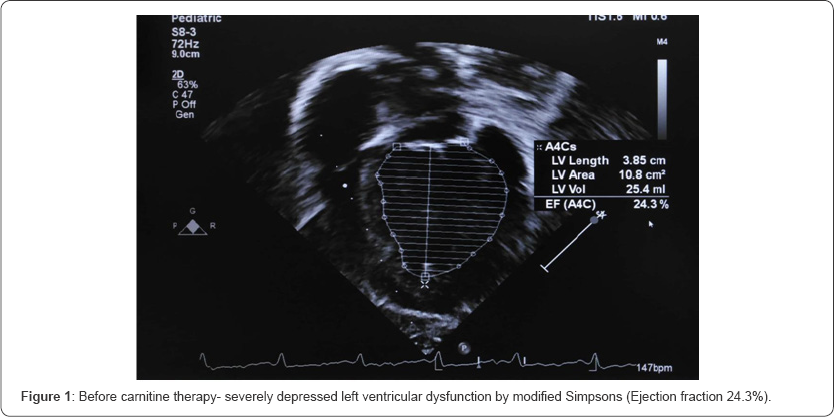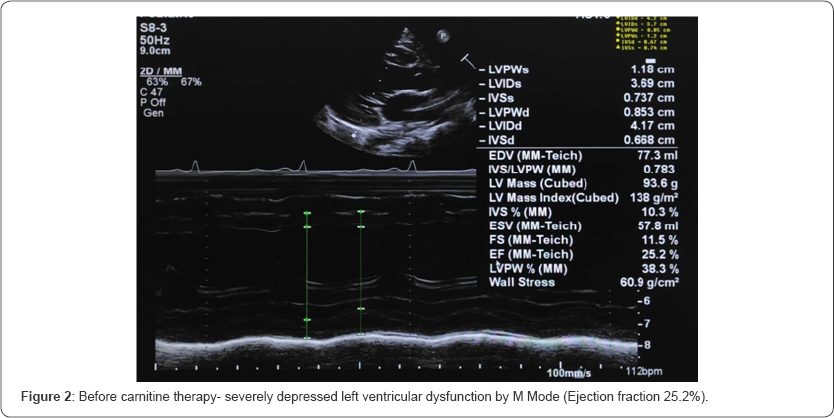Intradialytic Hypotension and Left Ventricular Function Improved After Intravenous Levo Carnitine Therapy in a Pediatric Hemodialysis Patient-Juniper Publishers
Abstract
Background: The significant decline of endogenous carnitine levels has been well confirmed in a single hemodialysis session. In children, owing to poor tissue stores, and growing demand, a resurgence in carnitine levels may take much longer time. Intradialytic hypotension secondary to carnitine deficiency is commonly due to depressed cardiac function. During hemodialysis, both oral carnitine and intravenous carnitine has been equally effective in adults by reducing the signs and symptoms. However, in children, intravenous carnitine may be more effective in the management of intradialytic hypotension and improving heart function.
Case presentation: We report a 9-year-old girl who is a known case of end-stage renal failure secondary to hypoplastic kidneys. Her dialysis is complicated with left ventricular systolic dysfunction, and tertiary hyperparathyroidism for which she underwent parathyroidectomy. She was significantly complicated with intradialytic hypotension which warranted her ultra filtrate rate not exceeding 0.2ml/kg/min. Further, she was investigated for carnitine levels which confirmed secondary carnitine deficiency. After the 6 months trial of 20mg/kg intravenous Levocarnitine for 5 times a week leads to remarkable improvement in intradialytic hypotensive episodes and cardiac function. Carnitine deficiency during hemodialysis and its management are well studied in adults but in pediatrics, it is very scarce. Herein we describe a pediatric patient with secondary carnitine deficiency in a pediatric hemodialysis patient and its successful management with intravenous carnitine.
Conclusion: Intravenous carnitine therapy successfully decreased intradialytic hypotensive episodes and significantly improved left ventricular function in our patient.
Keywords: Levo (L) carnitine; Intradialytic hypotension (IH); Ejection fraction (EF); Hemodialysis (HD)
Introduction
Supplementation of carnitine is essential in hemodialysis (HD) patient as it is a very paramount nutrient for the transfer of long-chain fatty acids across mitochondria and for subsequent beta oxidation [1]. Moreover, it is cardinal in patients on dialysis who suffer from severe carnitine deficiency as they tend to lose significantly from dialysis. Also, a significant reduction of endogenous carnitine levels has been well established with a single HD session. However, in the 2-day inter-dialytic period, plasma Levo(L)-carnitine levels were restored as body carnitine levels equilibrated and L-carnitine moved out of the tissue stores and replenished the plasma carnitine pool [2-5]. Carnitine deficiency also has profound effects on cardiac, skeletal muscles, and red blood cells. But in children, owing to poor tissue stores, and growing demand, a resurgence in carnitine levels may take much longer time. As a result, significant intradialytic hypotension (IH) secondary to carnitine deficiency has been well documented in pediatric HD patients [2-6].
Depressed cardiac function and decreased tissue perfusion are the predominant factors responsible for IH. In adults, both oral carnitine and intravenous have been effective in reducing the signs and symptoms during dialysis. However, in children, intravenous carnitine could be more effective in the management of IH and heart function [2-7]. Carnitine deficiency during HD and its management are well studied in adults but the recommendation on intravenous carnitine therapy in children are very few [3-7]. Herein we describe a pediatric patient with secondary carnitine deficiency in a pediatric HD patient with severe IH, poor cardiac function, poor tissue perfusion and its successful management with intravenous carnitine therapy.
Case Presentation
We report a 9-year-old girl who is a known case of end-stage renal failure secondary to bilateral hypoplastic kidneys. She is maintained on intermittent HD through a right internal jugular vein (permcath) from 6 years of age because of failed peritoneal dialysis. Her chronic HD (Fresenius 5008) regimen consisted of dry weight -20kg, blood flow 100ml/minute (5ml/kg), dialysate flow 400ml/minute, dialyzer (Fresenius-high flux {Fx} 40), heparin loading and maintenance 10 units/kg/hour), dialysate bath -(Sodium 140, potassium 2, calcium 1.5, bicarbonate 35mmol/l).
Her average intradialytic weight gain was significantly high (1litres- 2.2liters) needing 5 sessions of HD per week. Despite frequent sessions of HD and tight control of fluids, she was significantly complicated with IH which warranted her ultra filtrate rate not exceeding 0.2ml/kg/min. Her end-stage renal disease is complicated with left ventricular (LV) systolic dysfunction, and tertiary hyperparathyroidism for which she underwent total parathyroidectomy.


Her initial echocardiogram revealed severe depressed LV dysfunction- Ejection Fraction (EF) by modified Simpsons {24.3%}, M mode EF {24.2%} (Figure 1 &2). In relation to her hypertension related to end-stage renal failure, she is maintained on angiotensin-converting enzyme inhibitors. Further, she was investigated for carnitine levels which confirmed secondary carnitine deficiency (Table 1). After the 6 months trial of 20mg/kg of intravenous carnitine for 5 times a week (end of dialysis) leads to remarkable improvement in IH episodes and cardiac function. Her repeated echocardiogram revealed improved LV function- modified Simpsons {54.1%}, M mode EF {50.4%} (Figure 3 & 4).


Discussion
L- Carnitine is an important nutrient and may exhibit a beneficial effect on metabolic parameters [1,2]. In HD patients, carnitine is significantly lost through the membrane and cause significant intradialytic symptoms especially hypotension, and cramps. Moreover, it has a significant effect on morbidity and mortality. Patients with chronic renal failure or dialysis tend to have secondary carnitine deficiency as evidenced by normal to high plasma total carnitine concentration and high acyl to free carnitine (AC: FC) ratio but the free carnitine concentration is reduced [2-7].
Our patient had secondary carnitine deficiency secondary to hemodialysis as evidenced in (Table 1). Also, children on dialysis other causes of carnitine deficiency are low nutritional intake and progressive renal parenchyma loss which eventually removes the Table 1: Describes low free carnitine and high carnitine ratio suggestive source of endogenous carnitine synthesis [2-7]. Eknoyan et al. [8] highlighted the clinical indication of L-carnitine in HD patients are anemia, cardiomyopathy, IH and muscle weakness.

Similarly, in adults, many observational studies listed the importance of supplementation of L-Carnitine in HD patients [7]. Moreover metanalysis published in 2002 described the need of L carnitine in HD patients. However, a meta-analysis in 2008 has failed to demonstrate any advantage of L carnitine therapy in HD patients [7,9-11]. But in children, a meta-analysis on oral and intravenous carnitine therapy has not been studied yet.
Intravenous carnitine therapy has shown to improve myocardial fatty acid imaging in adults, but in contrast, only a few studies have investigated the association of cardiac function and carnitine therapy in children receiving HD [7,12-14]. Oral carnitine has been shown to improve LV function in two randomized placebo-controlled studies [13]. But, Topaloglu et al. [3] have described the carnitine supplementation through intravenous route did not improve cardiac function significantly [7]. However, a prospective pilot study done by Ronald et al. [7] showed 20mg/kg of intravenous carnitine for 6 months trial has shown some improvement in cardiac function.
Conclusion
To conclude, intravenous carnitine therapy successfully decreased IH and significantly improved LV function in our patient.
Declarations
Consent
Written informed consent for the publication of this case report and any accompanying images has been obtained from his father. A copy of the written consent is available for review by the Editor of this journal.
Data availability
The data that support the findings of this study are available from the corresponding author on request.
Conflict of interest
The authors declare that they have no competing interests.
Authors'contributions
a) Mohammed Azar: Clinical management, follow up, data collection and writing and review of the manuscript.
b) Al Mokali Khamisa: Clinical management.
c) Khalid Al Fakeekh: Review of the manuscript.
For more Open Access Journals in Juniper Publishers
please click on: https://juniperpublishers.com/open-access.php
For more articles in Open Access Journal of Cardiology & Cardiovascular Therapy please click on: https://juniperpublishers.com/jocct/index.php


Comments
Post a Comment